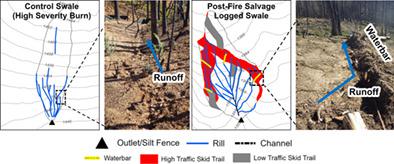当前位置:
X-MOL 学术
›
Hydrol. Process.
›
论文详情
Our official English website, www.x-mol.net, welcomes your
feedback! (Note: you will need to create a separate account there.)
Factors affecting connectivity and sediment yields following wildfire and post‐fire salvage logging in California's Sierra Nevada
Hydrological Processes ( IF 2.8 ) Pub Date : 2020-11-20 , DOI: 10.1002/hyp.13984 Will H. Olsen 1 , Joseph W. Wagenbrenner 2 , Peter R. Robichaud 3
Hydrological Processes ( IF 2.8 ) Pub Date : 2020-11-20 , DOI: 10.1002/hyp.13984 Will H. Olsen 1 , Joseph W. Wagenbrenner 2 , Peter R. Robichaud 3
Affiliation

|
Sediment delivery following post‐fire logging is a concern relative to water quality. While studies have assessed the effect of post‐fire logging on sediment yields at different spatial scales, none have explicitly identified sediment sources. Our goal was to quantify post‐fire and post‐salvage logging sediment yields and use rill patterns to identify sediment sources. We measured the extent and type of logging disturbance, length of rills per unit area or “rill density”, ground cover, and sediment yields in nine logged and five control small catchments or “swales”, 0.09 to 0.81 ha, for 5 years after the 2013 Rim Fire in California's Sierra Nevada. The logged swales had a mean ground disturbance of 31%. After the first wet season following logging, there was no difference in either mean rill density (0.071 and 0.088 m m−2, respectively) or mean transformed, normalized sediment yields between the control and logged swales. Untransformed mean sediment yields across three sites ranged from 0.11–11.8 and 1.1–3.2 Mg ha−1 for the controls and salvage‐logged swales, respectively. Rill density was strongly related to sediment yield and increased significantly with the amount of high‐traffic skid trail disturbance in logged swales. Rill density was not significantly related to the amount of bare soil despite a significant relationship between sediment yields and bare soil. Rills usually initiated in bare soil and frequently connected high traffic skid trails to the drainage network after being diverted by waterbars. Rill connectivity and sediment yields decreased in control and logged swales where vegetation or other surface cover was high, suggesting this cover disconnected rills from the drainage network. Increasing ground cover on skid trails and between areas disturbed by post‐fire logging and stream channels may reduce sediment yields as well as the hydrologic connectivity between hillslopes and the drainage network.
中文翻译:

加利福尼亚内华达山脉的野火和大火后伐木后,影响连通性和沉积物产量的因素
火灾后采伐后的泥沙输送是一个与水质有关的问题。尽管研究评估了不同空间尺度上的后伐木对沉积物产量的影响,但没有一个能明确识别沉积物来源。我们的目标是量化火灾后和救助后的测井沉积物产量,并利用钻孔模式识别沉积物来源。我们测量了9年的采伐和5个控制小型集水区或“流域”(0.09至0.81公顷)的测井扰动的程度和类型,每单位面积的小溪长度或“钻探密度”,地被植物以及沉积物的产量,持续了5年,为0.09至0.81公顷2013年加州内华达山脉的环火。伐木后的沼泽对地面的平均干扰为31%。伐木后的第一个湿季后,平均钻探密度(0.071和0.088 m m -2)均无差异或平均值),即在对照和记录的沼泽之间平均转化的,标准化的沉积物产量。三个站点的未转化平均沉积物产量在0.11–11.8和1.1–3.2 Mg ha -1之间分别用于控制和残存记录的沼泽。ill草密度与沉积物产量密切相关,并且随着伐木场高流量滑道干扰的增加而显着增加。尽管沉积物产量与裸土之间存在显着的关系,但沟ill密度与裸土的量没有显着相关。小河通常始于裸露的土壤,并经常被高水位改道后连接到排水网络的高流量滑道。在植被和其他地表覆盖率较高的控制沼泽和伐木沼泽中,小河的连通性和沉积物产量下降,表明该覆盖层使小溪与排水网络断开。
更新日期:2021-01-13
中文翻译:

加利福尼亚内华达山脉的野火和大火后伐木后,影响连通性和沉积物产量的因素
火灾后采伐后的泥沙输送是一个与水质有关的问题。尽管研究评估了不同空间尺度上的后伐木对沉积物产量的影响,但没有一个能明确识别沉积物来源。我们的目标是量化火灾后和救助后的测井沉积物产量,并利用钻孔模式识别沉积物来源。我们测量了9年的采伐和5个控制小型集水区或“流域”(0.09至0.81公顷)的测井扰动的程度和类型,每单位面积的小溪长度或“钻探密度”,地被植物以及沉积物的产量,持续了5年,为0.09至0.81公顷2013年加州内华达山脉的环火。伐木后的沼泽对地面的平均干扰为31%。伐木后的第一个湿季后,平均钻探密度(0.071和0.088 m m -2)均无差异或平均值),即在对照和记录的沼泽之间平均转化的,标准化的沉积物产量。三个站点的未转化平均沉积物产量在0.11–11.8和1.1–3.2 Mg ha -1之间分别用于控制和残存记录的沼泽。ill草密度与沉积物产量密切相关,并且随着伐木场高流量滑道干扰的增加而显着增加。尽管沉积物产量与裸土之间存在显着的关系,但沟ill密度与裸土的量没有显着相关。小河通常始于裸露的土壤,并经常被高水位改道后连接到排水网络的高流量滑道。在植被和其他地表覆盖率较高的控制沼泽和伐木沼泽中,小河的连通性和沉积物产量下降,表明该覆盖层使小溪与排水网络断开。











































 京公网安备 11010802027423号
京公网安备 11010802027423号